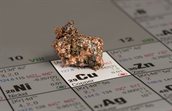Calculation method for critical raw materials
Critical raw materials are natural metals and minerals that are essential to our economy and society. They also have a high risk of supply disruption, for example because extraction is concentrated in certain regions.
The European Union (EU) has developed a calculation method to identify raw materials that are considered critical. According to this calculation method, a raw material is critical if:
- It is only produced in a limited number of countries, which also have a low governance indicator score (according to the World Bank).
- Its production is highly concentrated in countries with unfavourable governance indicator scores (according to the World Bank).
- Europe is highly dependent on imports of the raw material or the processed raw material (semi-finished product).
- The raw material has a low recycling rate.
- There is a lack of rapid, technically and economically sound substitutes.
- The raw materials are used in sectors of economic importance to the EU.
“The raw materials that are most important economically and have a high supply risk are called critical raw materials.” (Source: Council of the European Union and the European Council)
Essential role
Critical raw materials (according to the EU Council and the European Council) are essential for:
- Climate, energy, and environment: clean technology requires raw materials - they are irreplaceable in solar panels, wind turbines, electric vehicles, and energy-efficient lighting. Raw materials are therefore an essential basis for a more sustainable future.
- Industrial value chains: non-energy raw materials play a crucial role in almost all industries (e.g. mechanical engineering, metallurgy, and automotive) across all stages of the supply chain.
- Strategic technologies (such as healthcare): technological progress and higher quality of life depends on a varying and growing number of raw materials.
The European Commission website features several infographics from the Joint Research Centre (JRC), including on critical raw materials used in various technologies.
Where do critical raw materials come from?
Critical raw materials are of high economic importance for the Netherlands and the EU. The Ministry of Foreign Affairs website states that the extraction of critical raw materials is mainly concentrated in a small number of countries. For example, China is a major producer of rare earth elements, the Democratic Republic of Congo supplies almost all cobalt, and Australia and Chile are among the largest suppliers of lithium.
Before these raw materials can be used they first need to be refined (industrially processed). For many raw materials this processing step is highly concentrated in China. After processing, many raw materials are transported to Europe and can be used in production.
To view a map of the global distribution of critical raw material production, see the page 'Raw materials worldwide'.
